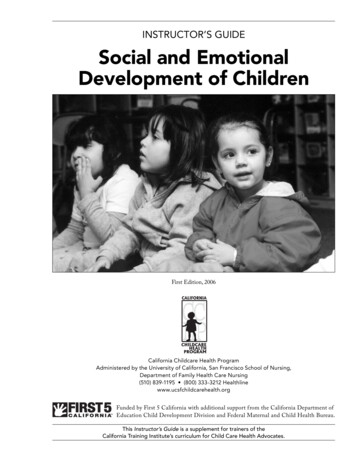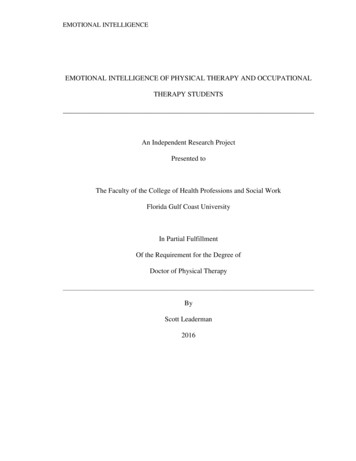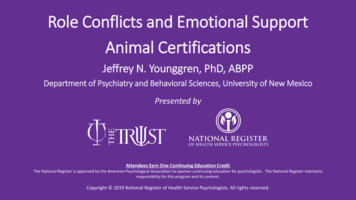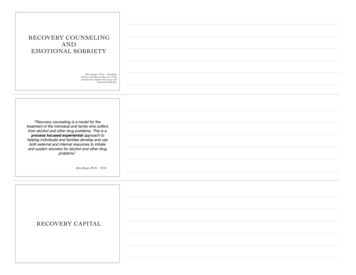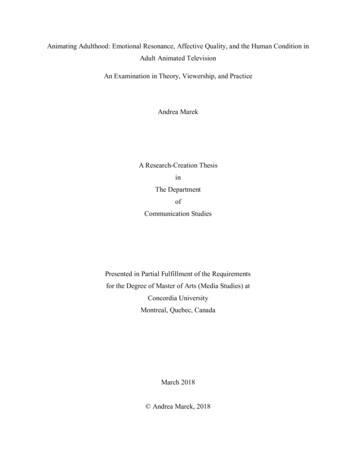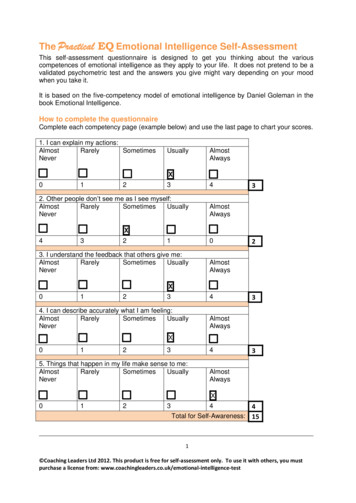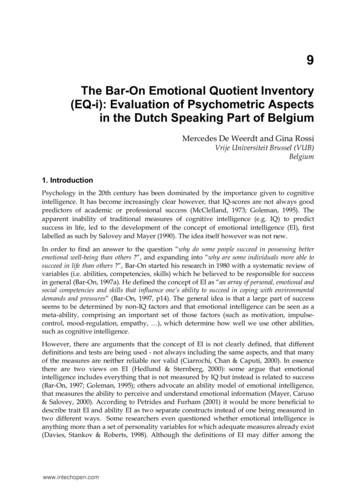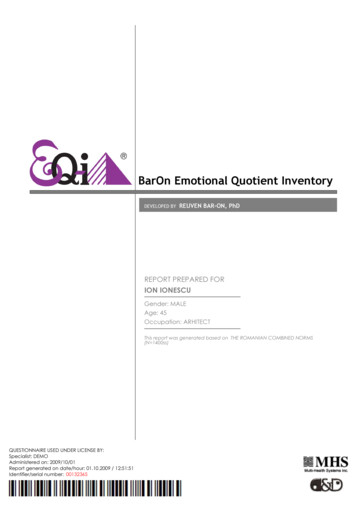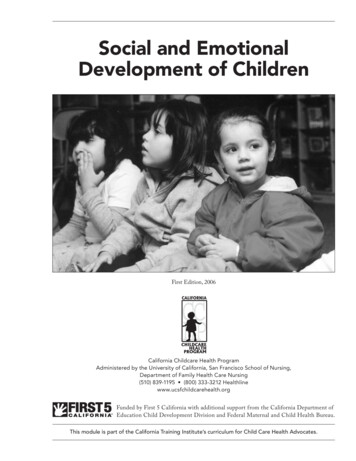
Transcription
Social and EmotionalDevelopment of ChildrenFirst Edition, 2006California Childcare Health ProgramAdministered by the University of California, San Francisco School of Nursing,Department of Family Health Care Nursing(510) 839-1195 (800) 333-3212 Healthlinewww.ucsfchildcarehealth.orgFunded by First 5 California with additional support from the California Department ofEducation Child Development Division and Federal Maternal and Child Health Bureau.This module is part of the California Training Institute’s curriculum for Child Care Health Advocates.
AcknowledgementsThe California Childcare Health Program is administered by the University of California,San Francisco School of Nursing, Department of Family Health Care Nursing.We wish to credit the following people for their contributionsof time and expertise to the development and review of this curriculum since 2000.The names are listed in alphabetical order:Main ContributorsAbbey Alkon, RN, PhDJane Bernzweig, PhDLynda Boyer-Chu, RN, MPHJudy Calder, RN, MSLyn Dailey, RN, PHNJoanna Farrer, BA, MPPRobert Frank, MSLauren Heim Goldstein, PhDGail D. Gonzalez, RNJan Gross, BSN, RNSusan Jensen, RN, MSN, PNPJudith Kunitz, MAMardi Lucich, MACheryl Oku, BATina Paul, MPH, CHESPamm Shaw, MS, EdDMarsha Sherman, MA, MFCCKim To, MHSEileen Walsh, RN, MPHSharon Douglass Ware, RN, EdDMimi Wolff, MSWRahman Zamani, MD, MPHEditorCatherine Cao, MFACCHP StaffEllen Bepp, Robin Calo, Sara Evinger, Krishna Gopalan, Maleya Joseph, Cathy Miller, Dara Nelson,Bobbie Rose, Griselda ThomasGraphic DesignersEdi Berton (2006)Eva Guralnick (2001-2005)California Childcare Health ProgramThe mission of the California Childcare Health Program is to improve the quality of child care by initiating andstrengthening linkages between the health, safety and child care communities and the families they serve.Portions of this curriculum were adapted from the training modules of the National Training Institute for Child Care HealthConsultants, North Carolina Department of Maternal and Child Health, The University of North Carolina at Chapel Hill; 2004-2005.Funded by First 5 California with additional support from the California Department of Education Child Development Divisionand Federal Maternal and Child Health Bureau.
LEARNING OBJECTIVESTo describe the social and emotional development of young children.To identify why young children behave in different ways.To describe the impact children with challenging behaviors have on early care and education (ECE) programs,staff and families.To describe three ways a Child Care Health Advocate (CCHA) can assist ECE programs with meeting theneeds of children with behavioral health problems.To identify resources available to assist and support ECE providers and families.RATIONALEAn important role of the CCHA is to help ECE providers and families work together to support children’ssocial and emotional development, and to provide resources and referrals for families who need them. ECEproviders spend a great deal of time and energy managing children’s behavior. Many children in ECE programsshow difficult or hard-to-manage behaviors. To be able to work well with all children and their families, CCHAsneed to understand children’s social and emotional development and to understand why children behave the waythey do. In this module, the terms difficult, challenging and hard-to-manage all mean the same thing when theyare used to describe behavior.Social and Emotional Development of ChildrennCalifornia Training InstitutenCalifornia Childcare Health Programn1
WHAT A CCHANEEDS TO KNOW child abuse exposure to violence in the home or the community parent-child relationshipTo encourage healthy social and emotional development, ECE providers must be familiar with the various stages of development for young children, as wellas understand that each child develops at his or herown pace. The process and timing of development isnot the same for every child. parents’ ability to cope with demands of parenting parents’ self-esteem capacity to protect the child from overstimulation social supportsThe first 5 years of life are a critical time in the development of young children. Children’s early social andemotional development depends on a variety of factors, including genes and biology (e.g., physical health,mental health and brain development) and environmental and social issues (e.g., family/community, parenting and child care). These factors can have a positive or negative influence on children’s development.Some children may have difficult behaviors that makeit harder to adjust to an ECE program (Haring, Barratt & Hawking, 2002). Research shows that braindevelopment during the first 5 years of life createslearning patterns that can last a lifetime. ECE programs which create trusting, safe and developmentally appropriate environments can help children learnto adjust to changes in their lives, get along well withothers and be healthy. A socially and emotionallyhealthy child will be ready to start school and thus,fully participate in learning experiences and formgood relationships with caregivers and peers (PethPierce, 2000).THE ROLE OF THE CCHAThe following issues, either within the child or withinthe environment, influence young children’s social andemotional development in the first 5 years of life: overall physical health of the child child’s temperament (style of behavior the childis born with) family stress and resources available to providesupport and how this is handled community stress and resources child’s experience in ECE programs, includingchild-ECE provider relationships, group size,training for ECE providers, expectations ofECE providers and consistency in caregiving goodness of fit between the child and the parent(Does the child meet the parents’ expectations?Do their temperaments match?)2nSocial and Emotional Development of ChildrennBecause CCHAs are often in the ECE program everyday, they can observe children playing with different people and at various times across a period of several weeks. Their role includes working closely withthe ECE staff to identify children whose behavior orhealth are of concern or raise questions. The CCHAcan talk about possible causes of troubling behavior,talk to the program director and Child Care HealthConsultant (CCHC), and participate in developinggood intervention strategies and action plans that focus on improving the social and emotional development of young children in ECE programs and thatfocus on addressing the behavior. CCHAs should alsomake sure staff and parents talk to one another regularly about any conflicts or problems, and support follow-up activities as necessary. The CCHA can serveas the key contact at the ECE program.Understanding BehaviorJust as physical development occurs in “ages and stages,” so too does social and emotional growth and development. Being familiar with the appropriate agesand stages of social and emotional development is important to be able to accurately understand children’sbehavior. There are many factors which affect a child’sbehavior that the CCHA should know about.Behavior is the main way children let adults knowwhat their needs are. Young children who cannot yetspeak often communicate by using body language andemotional expressions, such as crying, cooing or smiling. Children from birth to 5 years of age have a limited ability to understand and to express themselvesclearly using words. However, their general behavior,and ability to play well with other children and withadults can tell us a great deal. Good, objective obser-A Curriculum for Child Care Health Advocates
vation skills are the key to identifying what childrenneed. Even infants show signs as to their needs; ECEproviders need time to assess and interpret these signs.According to Poulsen (1996), some of the ways children tell us they are stressed and overwhelmed is whenthey show these behaviors on a regular basis:stand the function of the behavior (what is the purposeit serves for the child). Use the following three questions to begin the process of understanding challenging behavior: Are overactive.2. How do you know that is the reason? Have difficulty focusing on or completing a task.3. What should be done? Become easily frustrated. Have difficulty making decisions. Have difficulty following directions. Solve problems by hitting, biting, grabbing orpushing. Have tantrums. Cling to adults. Avoid new tasks. Do not play with other children. Cry frequently and cannot be soothed easily. Do not eat.1. Why is this happening? (What is the child getting from this behavior?)For a child with challenging behavior it is importantfor ECE providers and parents to work together andtalk openly. ECE providers need to tell parents whatis going on in the ECE program. And parents need totell ECE providers what is going on at home. SeeTable 1 for more information.ECE providers spend a fair amount of time teachingand modeling good behaviors and managing inappropriate behaviors of children in ECE programs. Positive behaviors are encouraged while negative behaviors are not rewarded or given undue attention.Understanding the specific reasons behind a child’sbehavior is important. The Program for Infant-Toddler Caregivers (PITC) defines five possible causesfor behavior in young children ( Johnston & Thomas,n.d.). See Table 1 for more information.Young children are still learning how to be social andhow to control their behaviors. Sometimes it is hardto tell whether a certain behavior is typical for a certain age or whether it is part of a larger problem. Ofcourse, extreme behavior that consistently happens inmore than one setting and with different ECE providers is of particular concern. Children who disruptthe routines of the ECE program cause a great deal ofstress for ECE providers. Learning the possible causeof the behavior may help ECE providers work withthe child to improve his or her behavior.The best way to learn about a child’s behavior is toobserve and collect information that can describe thecharacteristics of the behavior in a variety of settingsand situations. See Handout: Behavioral Data Collection Sheet for more information. Be objective and takeat least 15 to 20 separate observations in different settings over 2 to 5 days. Be sure to include both past andcurrent information collected from the parents. Gather all of the information until a clear pattern developsand you know whether your original hypothesis for whyyou think the behavior is happening is right or wrong.A log documenting positive and negative behaviorcombined with the parent’s information can offer auseful way for parents and ECE providers to shareinformation with one another and with other professionals. Collecting all this information allows you tobetter see the relationship between the child’s environments and the challenging behavior, and to seewhether there have been changes in the child’s behavior. With these observations, the ECE provider candevelop an intervention plan tailored to meeting thechild’s needs. If the ECE provider has made a largeeffort and things still are not better, look at differentways to observe the child’s behavior or seek more help(Kaiser & Rasminsky, 1999).To figure out possible causes for a child’s behavior,first come up with a hypothesis—a potential reason forwhy the behavior is occurring. Second, try to under-Social and Emotional Development of ChildrennCalifornia Training InstitutenCalifornia Childcare Health Programn3
TABLE 1: TOWARD A BETTER UNDERSTANDING OF CHILDREN’S BEHAVIOR:POSSIBLE CAUSES OF BEHAVIOR PROBLEMS AND ACTIONSFirst Possible Cause: Developmental StageWhy is this happening?What are the clues?The behavior is a usual part ofdevelopment and is due to thechild’s developmental stage. I have seen other children atthe same developmental stagebehave this way.The child is learning a newdevelopmental skill and ispracticing I have read about it in childdevelopment books.What actions should ECEproviders take?Relax. All children behave thisway. The behavior will changewith development. Find waysto make it safe for the child topractice the skill, which sendsa message to the child: “Iknow it is important.”Channel: Allow the behaviorin certain situations and atcertain times (as long as noharm is being done to othersor to the child).Stop: Stop the behavior when itis disruptive or dangerous.Second Possible Cause: Individual DifferencesWhy is this happening?What are the clues?What actions should ECEproviders take?Temperament accounts fordifferences in behavior. Not due solely to developmentalstage.Observe. Observe and identifyeach child’s unique style.All children experience the worlddifferently based in part on theirtemperament. I have information aboutthe child’s temperament byobserving the child in the ECEsetting, and by talking to thechild’s parents about the child’sbehavior at home.Adapt. Adapt your expectationsand interactions with this childbased on temperamentalcharacteristics.Not all children of a certain age actin exactly the same ways. I have read about research ontemperament.Give choices. When possible,offer options that allow for andappreciate children’s uniqueexpressions and responses tothe world.Communicate. Ask parents forpossible explanations andsolutions.(Adapted from Understanding Your Child by John Hymes)4nSocial and Emotional Development of ChildrennA Curriculum for Child Care Health Advocates
Third Possible Cause: The EnvironmentWhy is this happening?What actions should ECEproviders take?What are the clues?The behavior is due to theenvironment or to conflictbetween different environmentsthe child spends time in. Behavior is not due todevelopmental stage or toindividual differences.Change. If the child isresponding to somethingspecific in the ECE setting,change the environment tohelp the child feel in control. In the ECE program, severalchildren behave in similarways.Environments might include thefollowing: ECE programAdapt. Adapt your expectationsto reduce conflict. There are differentexpectations of the child in thehome and ECE settings. home setting family routinesCommunicate. Ask parentsabout the characteristicsof the other environmentsthe child spends time in.Ask parents for possibleexplanations and solutions. The child is respondingto changes in the homeenvironment and showing asudden change in behavior athome. family lifestyle cultural contextFourth Possible Cause: The Child Does Not Know but Is Ready to LearnWhy is this happening?What actions should ECEproviders take?What are the clues?The child does not knowsomething but is ready to learn. Behavior is not due todevelopment, individualdifferences or the environment.It may take time for a child tounderstand and to master newsocial rules.Teach. Teach a new skill, ruleor expectation, and explain itrepeatedly. Give reasons for thenew rule. The child is in a new orunfamiliar situation.Encourage. Give encouragementfor small successes. The child is facing a new taskor problem.Help. Offer help and be patientwith failures.Fifth Possible Cause: Unmet Emotional NeedWhat actions should ECEproviders take?Why is this happening?What are the clues?The child may have missed outon some part of development thatwas emotionally important. The behavior is developmentallyinappropriate (child is not actinghis age).Respond. Respond to the child’sneeds actively with actions andsupport.The child may be searching fornew ways to meet this need. The behavior is consistentacross time and place.Be firm. Meet the child’s needswith quiet firmness andpatience. The behavior has a drivenquality as if the child has todo it.Control. Remember that thechild cannot stop or control thebehavior. The usual ways of handling andhelping most children with thisbehavior do not seem to behelping.Social and Emotional Development of ChildrennCalifornia Training InstituteSeek help. Get more supportfor yourself, the child and thefamily.nCalifornia Childcare Health Programn5
What Is Temperament?Temperament is the natural, inherited style of behavior of each person. It is a combination of inborn traitsand personal experience that shapes how we see andrespond to the world around us. It is the “how” ofbehavior, not the “why.” It is important to understandhow children’s temperament influences their behavior(see Handout: Temperament and Behavior). For example, some children are always hungry at the same timeof day and like to eat the same thing everyday. Otherchildren are hungry at different times of the day andlike to change what they eat. The following are ninetypes of temperamental characteristics that can bechallenging for ECE providers and families (Rothbart, Derryberry & Hershey, 2000):High Activity. Very active, always into things. Makesyou tired. “Ran before he walked,” gets wild or “revvedup,” loses control easily. Hates to be restricted or confined (does not like car seats, strollers, high chairs).High Distractibility. Has difficulty concentratingand paying attention, especially if not really interested; seems not to be listening.High Intensity. A loud child whether miserable, angry or happy. Highs are higher and lows are lower;considered very dramatic.Irregular. Unpredictable. Cannot tell when he or shewill be hungry or tired, constant conflict over mealsand bedtime, moods change suddenly, wakes often atnight. See Handout: Health and Safety Notes: Temperament and Regularity for more information.Negative Persistence. Stubborn, goes on and onnagging or whining if wants something, will not giveup. Seems to get “locked in” to a behavior; tantrumscan be long and hard to stop.Very Sensitive. Sensitive to sounds, lights, colors,textures, temperature, pain, tastes or smells. Clotheshave to “feel right,” making dressing a problem. Doesnot like the way many foods taste. Overreacts to minor injuries. Easily overstimulated.Initial Withdrawal. Does not like new situations:new people, places, food or clothes. Often hesitates,and protests by excessive crying or clinging. Needs timeto “warm up.”6nSocial and Emotional Development of ChildrennSlow Adaptability. Has a hard time with changesand going from one activity to another; even after initial response, takes a long time to adapt to anythingunfamiliar. Gets used to things or routines and refusesto give them up. Strong preferences for certain foodsor clothes.Negative Mood. Frequently serious or cranky.Whines or complains a lot. Not a “happy child.”It is key to note that behaviors that may be difficult orchallenging for one ECE provider may be easy foranother, as individual expectations and interactionsvary. This highlights the importance of a “goodness offit” in the child-ECE provider relationship (see Handout: Temperament and Goodness of Fit). ECE providersshould identify the child’s temperament and theirown (see Handout: Temperament Assessment Scale forChildren and Handout: Temperament Assessment Scalefor Caregivers). ECE providers should respect uniqueness and adapt without comparing, labeling or tryingto change the child (this is sometimes called positivereframing). In the end, it is necessary to recognize individual differences when matching an ECE providerwith an individual child.What Is Challenging Behavior?There is an endless list of challenging (or hard-tomanage) behaviors, which may include, but are notlimited to, hitting, shoving, yelling, having tantrums,not sharing, throwing and breaking toys, grabbing,biting, spitting and kicking. And at one time or another, every ECE program has dealt with a child withsuch behaviors (see Handout: Health and Safety Notes:Caring for the Spirited Child). Challenging behavior isany disruptive or destructive behavior that does thefollowing: Gets in the way of the child’s learning, development and success at play. Is harmful to the child, other children or adults,or causes damage to the environment. Socially isolates the child because other childrendo not want to play with him or her. Puts the child at high risk for later social problems or problems i
San Francisco School of Nursing, Department of Family Health Care Nursing. We wish to credit the following people for their contributions of time and expertise to the development and review of this curriculum since 2000. Th e names are listed in alphabetical order: Main Contributors Abbey Al
